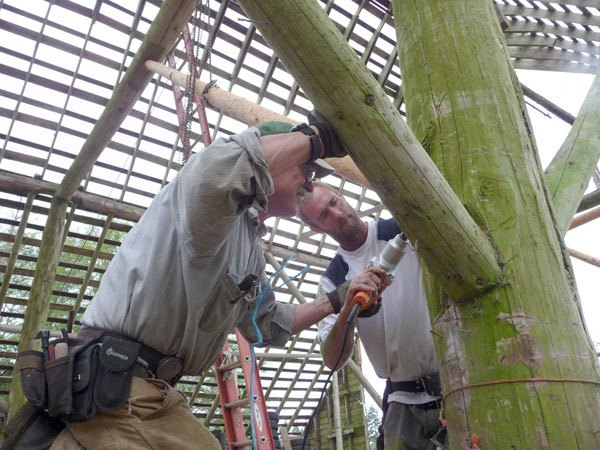The 75-year-old Frost barn with its broken gambrel-style roof is standing erect and proud again after three months of work replacing interior and exterior posts, a cross beam and braces.
Built to be open on three sides, the barn that’s 50 feet by 50 feet has been in Deborah Keeting-Hansen’s family since 1948 and until this spring, was in danger of collapsing due to a pronounced list on its east side.
Her husband, Paul Hansen, and a cadre of volunteers using a winch system raised up the sagging side, replacing three posts, one of which had sunk four feet into the ground, she said.
“They winched and pulled it and gradually it became straight but it always will be a little wonky,” Hansen said.
At first denied, after their second application, in 2014 the Hansens were approved for a $22,000 grant from the Heritage Grant program through the Washington State Department of Archaeology & Historic Preservation, Washington State Heritage Barn Register.
Last spring, the Hansens thought the restoration might cost as much as $40,000, half of that to be matched by them, but with engineering services donated, volunteers from the North Olympic Land Trust, friends and family, the actual cost of labor to restore the former dairy barn, now a working barn for the Hansens’ sheep and hay, was kept to a minimum.
“Whatever we pay out of pocket the state will pay half,” Hansen said. “The roof was $5,500 and we received $3,000 in donations so our part was $2,500.”
NOLT volunteers stripped the 4,100-square-foot roof of its original 3-foot long cedar shakes over three days. More skip sheeting was added and Paul, his nephew J.P. Carl, a professional roofer, and friend Ryan Fournier were manhandling sheets of corrugated steel 2 feet wide by lengths of 5, 12 and 25 feet up a narrow ladder to the roof last week.
They also beefed up the interior by adding pairs of 18-foot braces.
The contract with the state has three stipulations: that the restoration be finished by June 30; that it have cedar shakes or a corrugated steel roof in keeping with its original look; and that it be open to the public.
Foregoing the shakes was an easy decision for the Hansens.
“It would have taken old-growth trees for the shakes and the cost would have been prohibitive, so the next best thing was corrugated steel because it was old-fashioned enough for the state,” Hansen said.
Now that they are down to the short rows, Hansen reflected, “I really worried we’d pull it off because I thought it would be very expensive and take a lot of workers and the toll it would take on my husband, but it’s gone surprisingly well and quickly, especially the work on the roof. Paul’s been doing most of the work along with tending the sheep and other jobs and J.P.’s a professional roofer, but they pulled it off. Paul said it’s been fun.
“After the roof’s done, we need to rebuild the barn door and do some work on the west wall of the milking parlor and that’s about it. Sometime we’ll have to have a party after I recover my nerves!”
If Paul Hansen has been the structural brawn and brains of the restoration, then Deborah Hansen has been the barn’s heart and soul.
Deborah Keeting grew up on the farm with her parents, Ralph and Ninna Keeting, who bought 67 acres from dairy farmer Henry Frost in 1948. Frost felled fir and cedar timber from the farm’s forest to construct the barn.
It was built as an open-sided hay barn nearly 75 years ago to prevent spontaneous combustion of drying hay. The west side had a milking parlor and Deborah’s father milked a dozen cows for Darigold over 14 years. The barn used a system of a claw and pulleys to bring the loose hay in for storage until 1960 when they began baling hay. The hay hook is now property of the Sequim Museum & Arts Center, courtesy of Deborah’s mother, Ninna.
“I feel this is a monument to my parents and a piece of Sequim history and in memory of Mr. Frost. We’re losing so many barns and that this could be saved is really neat and important for the community,” Hansen said.
“This is not just profiting us but the community. It’s preserving history and the memory of people who built this valley. My mom was one of the founders of the Sequim Museum and she recorded the history of the Dungeness Valley. We’re going to donate the best shakes to the Clallam County Historical Society and to the Sequim Museum & Arts Center for its new museum. My mother would be very pleased with that.”
The farm is part of the North Olympic Land Trust and its volunteers who helped are Linda Button, Elden Housinger, Stephen Langley, Michael Tallmadge, Sarah Miller and Curt Batey. Others who donated time and expertise are Ryan Fournier, Michael Hannah, Delancey Hannah, Harold Anderson, Bill Sallee and Brad Norman. Family friend Dave LaRoux donated three large logs for the hefty exterior posts.
Emotionally, Hansen said, “It’s a tremendous relief because I really thought we were going to lose the barn. We couldn’t have done it without the grant, donations and volunteers and people who loaned Paul equipment. Community spirit is still strong within the farming community, plus the support from MAC, NOLT, the historical society and the Sequim Alumni Association. I also want to express my gratitude to all the volunteers and 40-50 donors and the help and support of the community to make this possible.”
The barn is at 340 Frost Road; call 681-6306 for an appointment to view it.



